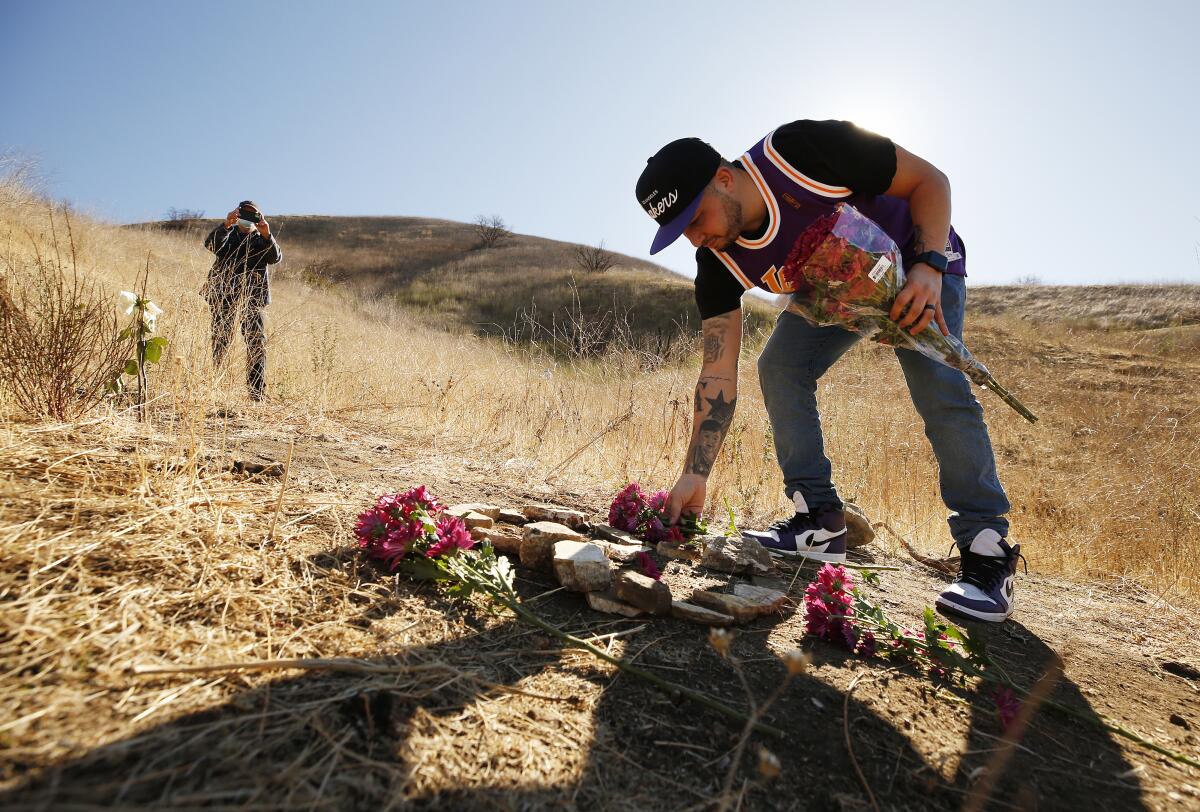Kobe Bryant crash findings give a boost to safety reforms backed by Vanessa Bryant

- Share via
The findings of a year-long federal investigation into the helicopter crash that killed Kobe Bryant, his daughter Gianna and others in Calabasas has sparked a new push for safety legislation that failed last year.
The National Transportation Safety Board determined the cause of the Jan. 26, 2020, crash was Ara Zobayan’s decision to fly under visual flight rules in cloudy conditions, which resulted in his spatial disorientation and loss of control of the aircraft. The board added that Zobayan’s “likely” self-induced pressure to get Bryant to his destination and inadequate review of safety management procedures by helicopter operator Island Express contributed to the crash.
Rep. Brad Sherman (D-Northridge) said Tuesday he will amend the Kobe Bryant and Gianna Bryant Helicopter Safety Act bill in Congress to include the NTSB recommendations of requiring new standards for initial and recurrent pilot training for helicopter operations and to convene a panel to evaluate technologies effective for training pilots to recognize the onset of spatial disorientation.
As initially filed, the bill would require terrain awareness and warning systems on all helicopters that carry six or more passengers, which the Sikorsky S-76B that carried Bryant and the others did not have. Despite a 2006 NTSB recommendation that such equipment be mandatory on all helicopters, the Federal Aviation Administration, which sets flight rules, only requires it on helicopter air ambulances.
Despite a personal plea from Vanessa Bryant, Kobe’s widow and Gianna’s mother, lawmakers did not pass the legislation last year. Opposition from the aviation industry, combined with a Congress overwhelmed with the COVID-19 pandemic and other issues, pushed helicopter safety to the back burner.
The NTSB, however, revealed during its hearing Tuesday that its investigators had concluded that a terrain awareness system would not have helped in the crash in Calabasas, as the pilot was not in controlled flight and was disoriented.
The aviation industry has argued that the systems are not always necessary for pilots and balked at the costs of installation and repair — upward of $35,000 per helicopter, plus hours of maintenance costs and time lost with repairs and installation.
The NTSB did recommend a number of actions to the FAA to improve helicopter safety, including implementing scenario-based training for changing weather conditions for helicopter pilots, and convening a panel of experts to “evaluate spatial disorientation simulation technologies to determine which applications are most effective for training pilots.” It also reiterated a previous recommendation for helicopter manufacturers to install systems that record cockpit audio and images with a view of the cockpit environment to include as much of the outside view as possible.
Some of the recommendations are now being incorporated into Sherman’s amended bill.
Bryant and his daughter Gianna, along with several of her teammates, a few parents and coaches, took off shortly after 9 a.m. from John Wayne Airport in Orange County, heading to Camarillo Airport for the second day of a weekend tournament at the Mamba Academy in Thousand Oaks. Also killed in the crash were Christina Mauser; Payton and Sarah Chester; John, Keri and Alyssa Altobelli; and Zobayan.
Zobayan, the NTSB noted, made a “poor decision” to fly at excessive speed in bad weather, and the helicopter was not in a controlled flight pattern when it crashed into the hillside near Las Virgenes Road and Willow Glen Street at 9:45 a.m.
NTSB member Michael Graham said Zobayan ignored his training, adding that as long as helicopters continue to fly into clouds while using visual flight rules “a certain percentage will not come out alive.”
NTSB investigator Bill English told the board that Zobayan informed air traffic control that he was “climbing to 4,000 feet” to get above the clouds. But English said the pilot was experiencing spatial disorientation because the helicopter banked to the left, away from the 101 Freeway, while communicating with the controller that it had descended.
Zobayan misperceived altitude and acceleration and suffered what is known as a somatogravic illusion, according to Dr. Dujuan Sevillian. He said the acceleration of the chopper could cause a pilot to sense the aircraft was climbing when it was not.
“Our inner ear can give us a false sense of orientation,” Sevillian said, noting that a lack of visual cues while being surrounded by clouds worsens the problem, and the pilot suffers what is known as “the leans.”
More to Read
Sign up for Essential California
The most important California stories and recommendations in your inbox every morning.
You may occasionally receive promotional content from the Los Angeles Times.














